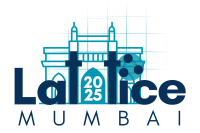Speaker
Description
Lattice quantum chromodynamics (LQCD) calculations are pushing the limits of today’s most powerful supercomputers. Since most resources are consumed in solving large systems of linear equations, efficient solvers, such as those based on adaptive multigrid methods, are essential. However, with the slowdown of Moore’s Law, it is uncertain whether traditional architectures can deliver the computational power and energy efficiency needed for future LQCD computations. In this talk, we explore photonic computing as a promising emerging paradigm to extend performance in the post-Moore’s Law era. By using photons instead of electrons, photonic processors enable ultra-low latency and energy-efficient matrix operations. To deal with the limited precision of the analog hardware, we introduce a mixed-precision photonic (MPP) solver based on multigrid methods, and present tests on a simple discretized partial differential equation as well as an emulated MPP solver applied to the 2D U(1) Schwinger model. Potential performance gains in both speed and energy efficiency are estimated to reach an order of magnitude, highlighting the potential of domain-specific photonic hardware to accelerate future LQCD calculations.
| Parallel Session (for talks only) | Software development and machines |
|---|

